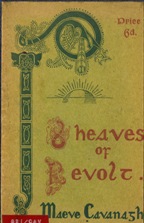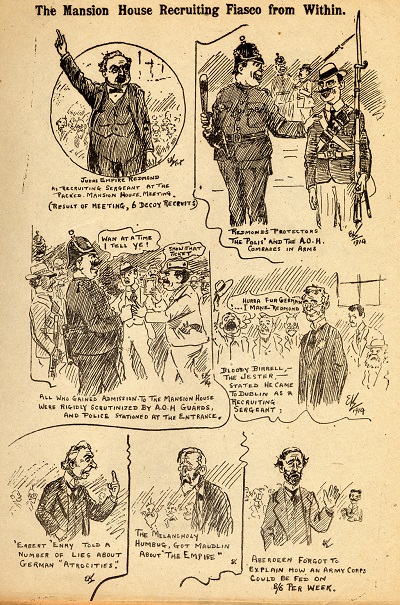Sheaves of Revolt: Maeve and Ernest Kavanagh
Published on 28th February 2018
 During the First World War, an estimated 200,000 Irish joined the British forces, a fact that did not sit well with the republican movement. Some dismissed the volunteers as mercenaries or misfits, while others took a more considered view. Maeve Kavanagh, born in South Frederick Street in 1878, was a noted republican poet and she often used her pen to take aim at men who volunteered for the British army. In her 1914 collection of poetry Sheaves of Revolt, she described the brutality and horror of war and its aftermath to dissuade Irishmen from volunteering:
During the First World War, an estimated 200,000 Irish joined the British forces, a fact that did not sit well with the republican movement. Some dismissed the volunteers as mercenaries or misfits, while others took a more considered view. Maeve Kavanagh, born in South Frederick Street in 1878, was a noted republican poet and she often used her pen to take aim at men who volunteered for the British army. In her 1914 collection of poetry Sheaves of Revolt, she described the brutality and horror of war and its aftermath to dissuade Irishmen from volunteering:
So hurry up and take the ‘bob’
The Butcher cannot wait,
The German guns are talking,
At a most terrific rate.
And if you should crawl back,
Minus arm or minus leg,
You’ll get leave to roam your city
To sell matches – or to beg.
Maeve’s brother, Ernest, was a talented cartoonist and his work was published in various republican and leftist newspapers: Irish Worker, Fianna and Irish Freedom. One of his most celebrated cartoons lampooned the recruiting rally held at the Mansion House on 25th September 1914, see image below (click to enlarge). The rally was addressed by both British Prime Minister Herbert Henry Asquith and John Redmond, leader of the Irish Parliamentary Party. At the meeting, Redmond repeated his call, made at Woodenbridge in Wicklow a few days earlier, for Irish recruits to join the British forces, while Asquith promised an Irish brigade or army corps. Kavanagh published his impressions of the Mansion House rally in the Irish Worker in early October 1914, characterising Redmond as ‘Judas Empire Redmond…recruiting sergeant at the packed Mansion House meeting’ and Asquith as ‘ ‘Erbert ‘Enry’, who lied about German atrocities on the continent. He also drew unflattering portraits of the Dublin Metropolitan Police and the Ancient Order of Hibernians, standing guard over the meeting. Ernest, a clerk at the Irish Transport and General Workers Union (ITGWU,) was shot dead by British troops on the steps of Liberty Hall during the Rising, while Maeve went on to be exceptionally active in the Gaelic League, Citizen’s Army and Cumann na mBan. Both Sheaves of Revolt and Ernest’s cartoons are available to view in Dublin City Library and Archives.
Despite opposition from nationalists, Irish recruitment into the British forces continued throughout the war, both into the traditional Irish regiments and into the other branches of service. The war memorial at Islandbridge quotes a figure of 49,500 Irish dead, which represents all those who died in Irish regiments; it is estimated that 35,000 of this total were Irish-born. Papers, artefacts and other items belonging to Irish participants in the First World War can be found in the Royal Dublin Fusiliers Association Archive at Dublin City Library and Archives. Search or browse Royal Dublin Fusiliers Association Archive online at Digital Repository Ireland.
Bernard Kelly, Historian in Residence, Dublin City Library and Archive.
